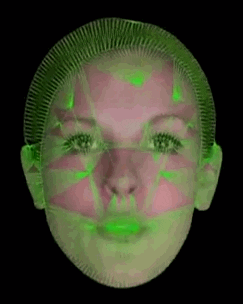
This technology could be the start of a whole new generation of interfaces which make interacting with a computer much more like talking to another human being.
Roberto Cipolla
Meet Zoe: a digital talking head which can express human emotions on demand with “unprecedented realism” and could herald a new era of human-computer interaction.
A virtual “talking head” which can express a full range of human emotions and could be used as a digital personal assistant, or to replace texting with “face messaging”, has been developed by researchers.
The lifelike face can display emotions such as happiness, anger, and fear, and changes its voice to suit any feeling the user wants it to simulate. Users can type in any message, specifying the requisite emotion as well, and the face recites the text. According to its designers, it is the most expressive controllable avatar ever created, replicating human emotions with unprecedented realism.
The system, called “Zoe”, is the result of a collaboration between researchers at Toshiba’s Cambridge Research Lab and the University of Cambridge’s Department of Engineering. Students have already spotted a striking resemblance between the disembodied head and Holly, the ship’s computer in the British sci-fi comedy, Red Dwarf.
Appropriately enough, the face is actually that of Zoe Lister, an actress perhaps best-known as Zoe Carpenter in the Channel 4 series, Hollyoaks. To recreate her face and voice, researchers spent several days recording Zoe’s speech and facial expressions. The result is a system that is light enough to work in mobile technology, and could be used as a personal assistant in smartphones, or to “face message” friends.
The framework behind “Zoe” is also a template that, before long, could enable people to upload their own faces and voices – but in a matter of seconds, rather than days. That means that in the future, users will be able to customise and personalise their own, emotionally realistic, digital assistants.
If this can be developed, then a user could, for example, text the message “I’m going to be late” and ask it to set the emotion to “frustrated”. Their friend would then receive a “face message” that looked like the sender, repeating the message in a frustrated way.
The team who created Zoe are currently looking for applications, and are also working with a school for autistic and deaf children, where the technology could be used to help pupils to “read” emotions and lip-read. Ultimately, the system could have multiple uses – including in gaming, in audio-visual books, as a means of delivering online lectures, and in other user interfaces.
“This technology could be the start of a whole new generation of interfaces which make interacting with a computer much more like talking to another human being,” Professor Roberto Cipolla, from the Department of Engineering, University of Cambridge, said.
“It took us days to create Zoe, because we had to start from scratch and teach the system to understand language and expression. Now that it already understands those things, it shouldn’t be too hard to transfer the same blueprint to a different voice and face.”
As well as being more expressive than any previous system, Zoe is also remarkably data-light. The program used to run her is just tens of megabytes in size, which means that it can be easily incorporated into even the smallest computer devices, including tablets and smartphones.
The Latest Bing News on:
Digital talking head
- A new approach to using neural networks for low-power digital pre-distortion in mmWave systemson May 10, 2024 at 9:27 am
In a study published in the journal IEICE Electronics Express, researchers present a neural network digital pre-distortion (DPD) for mmWave RF-PAs.
- Main Stage line-up revealed for Digital Construction Week 2024on May 10, 2024 at 1:50 am
With Digital Construction Week (DCW) rapidly approaching, the event organisers have revealed a must-see programme for the Main Stage of this year's show.
- ‘CTV gives you the experience of big screen with the precision of digital’on May 9, 2024 at 8:25 pm
The panellists were Jatin Punamiya, Head of Digital and Audience Data ... Lala started the discussion by talking about the big role CTV plays in today’s marketing landscape, and how AI is also one of ...
- Things aren't moving". Lukashenko on the need for early recognition of electronic digital signature in the EAEUon May 7, 2024 at 5:00 pm
President of Belarus Alexander Lukashenko said about the need to focus on the early recognition of electronic digital signature in the EAEU. He said this at a meeting of the Supreme Eurasian Economic ...
- Greg Hill talks about starring in the film ‘Civil War,’ and being a part of the digital ageon May 7, 2024 at 9:55 am
Actor Greg Hill chatted about starring in the film “Civil War,” and being a part of the digital age. ‘Civil War’ On his experience in “Civil War,” he said, Honestly, i ...
- Stable policies vital for Nigeria’s digital economy, says US envoyon May 6, 2024 at 8:01 pm
The United States of America Consul General to Nigeria, Will Stevens, has underscored the need for predictable policies to accelerate the growth of Nigeria’s digital economy.The US envoy made this ...
- Talking turkey with RSPCA Young Photographer Awards winner Jamie Smarton May 6, 2024 at 7:26 am
At eight years old, Jamie Smart is the youngest ever winner of the prestigious RSPCA Young Photographer Awards, along with her pet turkey ...
- Tyronn Lue comments on being a candidate for Lakers' head coaching jobon May 4, 2024 at 6:30 pm
It seems as if their preferred candidate may be Tyronn Lue. It makes sense, as Lue coached LeBron James and the Cleveland Cavaliers to an NBA championship in 2016. Lue also won two more rings as a ...
- Charles Barkley fires shot at NBA media over head coaching rumors: 'Do your damn job'on May 2, 2024 at 8:15 am
Charles Barkley came after NBA media on Wednesday night as rumors suggested Los Angeles Lakers coach Darvin Ham and Phoenix Suns coach Frank Vogel could be fired.
- Talking Pointson April 30, 2024 at 4:20 am
Mark Mason, CEO of Zebra, reflects on his 25 years in retail. JUST OVER 25 years ago I was happily working at the Burton Group when a press release came onto everybody’s screen (as one of the first ...
The Latest Google Headlines on:
Digital talking head
[google_news title=”” keyword=”digital talking head” num_posts=”10″ blurb_length=”0″ show_thumb=”left”] [/vc_column_text]The Latest Bing News on:
Digital assistants
- The digital town hallon May 10, 2024 at 12:15 pm
U.S. presidential election was in full swing at the start of my junior year of college. As a political science major, I considered it important to be an ...
- Apple set to deliver AI assistant for transcribing, summarizing meetings and lectureson May 10, 2024 at 8:33 am
Apple later this year hopes to make real-time audio transcription and summarization available system-wide on many of its devices, as the iPhone maker looks to harness the power of AI in delivering ...
- I tested Gemini as my Pixel assistant again, and it's gotten better - but there's a catchon May 9, 2024 at 2:44 pm
Android users who takes their privacy seriously and don't want AI to have access to the totality of the things they've saved to Google Drive need to pay attention to this.
- Gen Z is bringing back digital cameras and the post-night-out photo dumpon May 9, 2024 at 5:48 am
Curated social media feeds are out and real, messy photos capturing candid moments are in as Zoomers bring back digital cameras.
- AI Homework Helper Assistant for Students: Pros and Conson May 9, 2024 at 5:25 am
One such technological advancement is the emergence of AI homework helper assistants for students. These AI-powered tools offer a wide range of features designed to aid students in completing their ...
- AI ethicists warn of ‘digital hauntings’ from dead loved oneson May 8, 2024 at 5:00 pm
The internet is filled with personal artifacts, much of which can linger online long after someone dies. But what if those relics are used to simulate dead loved ones? It’s already happening, and AI ...
- Art faculty inspires students to design digital textbookson May 8, 2024 at 3:21 pm
Discover how our art faculty inspires students to push creative boundaries by designing their own digital textbooks, revolutionizing traditional learning method ...
- Life on the digital edge: Evolving your customer experienceon May 7, 2024 at 9:00 am
There is no one right way to obsess about your customers, but one thing is for sure—what you used to do is no longer enough.
- A judge has ordered the owners of get-rich-on-Amazon startup Wealth Assistants to have their assets frozenon May 2, 2024 at 10:47 am
Legal trouble mounts for Wealth Assistants, an Amazon automation business, as a judge freezes assets amid accusations of fraud.
- Top 10 Best AI Assistants in 2024on April 28, 2024 at 5:00 pm
There are several digital assistants that utilize AI technology. Some of the most popular ones include Siri, Alexa, Google Assistant, Cortana, Hound, and Bixby. These assistants use natural ...
The Latest Google Headlines on:
Digital assistants
[google_news title=”” keyword=”digital assistants” num_posts=”10″ blurb_length=”0″ show_thumb=”left”]









